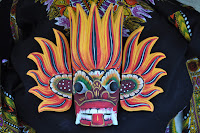Soon after lunch we headed towards the village of Hiriwaduna, so as to experience a bullock cart ride and have some typical food and beverage at one of the villager's.
Bullock carts are said to be living testimony of the traditions and practices of the past, though I must confess the actual "tourist" oriented ride was bumpy and not particularly interesting, had it not been for the surrounding wild landscape with a fairly wide variety of flora and fauna, interspersed with rice farming areas, which once more caught our attention.



We then stopped at the kitchen area of a local villager, who welcomed us with some tea, some very delicious bananas and a rather exquisite sweet paste folded in a leaf, that we were supposed to take whilst drinking the tea.
Having brought some school material with me in the form of decorated pencils and pens and realising one of the villager's adolescent daughters had just walked in her school uniform, I decided to give her some of those just before we left. ... and that was the first real moment that got me (us all) a little bit closer to this people and into something more than the mere "Ayboan" greeting.

We were given the chance of a total "immersion" into the Sri Lankan wood and silk craftsmanship by visiting two factories, which still use the old techniques in the carving of masks and other wooden objects, many of which ressemble some of the originals one can easily find in religious and historic sites, as well as the silk processing and tailoring of local outfits.
I couldn't resist buying some wooden masks particularly after having heard some of the provided information concerning the meaning of each of the different design,s but if on one hand I was mesmerised by the vibrant colours of some of the frightful looking masks, it were the vivacious and at times subtle gradation of colours in the silk garments that really caught my attention.

Three of the female in the group (I included) were asked to try on some saris, which took us a reasonable amount to drape even with the precious help of the assistants, as there are quite a few steps to be taken, starting with the wrapping of the sari, folding it into pleats, tucking it into the waistband and finally having the "pallu" (the decorative end of the sari) come diagonally in front of the torso and draped over the shoulder.


It was quite an experience, I must say, as trying one of those one is as much of an art as actually wearing it.
Saris are undoubtedely gracious, elegant and particularly sensuous in as much as they reveal and hide simultaneously ...
I ended up selecting a blue, pink and golden silk tissue and after having talked to the tailor decide on having him make me a three piece sari like garment to be delivered at the hotel the following evening. I must confess I am rather curious as to what it is going to look like...
By the end of the day we were a lot more aware of the traditional dress of Sri Lankan, as we passed by a few male wearing the typical sarongs wrapped around their wais, on the way back to the hotel, though I trust it won't be as complicated to wear them as the saris ...












No comments:
Post a Comment